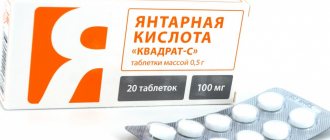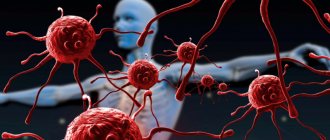Recently, there have been frequent cases of dog hunters poisoning domestic animals with the drug Isoniazid (Tubazid). Treatment for dog poisoning should begin as quickly as possible. To do this, you need to notice the symptoms of poisoning in time. You also need to be able to immediately provide assistance and take the dog to a veterinary clinic.
Isoniazid is an anti-tuberculosis drug used in human medicine. It is also used in veterinary medicine to treat Mycobacterium or Actinomyces infections. Isoniazid is available in injectable, liquid and tablet forms. It may also be used in combination with other medicines (for example, rifampicin).
Isoniazid reaches its maximum concentration in blood plasma approximately 1–2 hours after administration. The drug penetrates into all biological fluids of the body and cells and has low fat solubility. Isoniazid is metabolized in the liver and excreted from the body through urine. The half-life is 4 hours, but may be increased in case of overdose.
Isoniazid is generally used safely in many animal species and humans. However, this drug has a small safety factor in dogs because they cannot metabolize it. Just 1 tablet of isoniazid of 0.3 grams can lead to serious intoxication of a dog weighing 5 kilograms. Treatment for dog poisoning should be started immediately!
pharmachologic effect
Antituberculosis drug; acts bacteriostatically. It is a prodrug - mycobacterial catalase-peroxidase metabolizes isoniazid to an active metabolite, which, by binding to enoyl (acyl-transfer protein) reductase fatty acid synthase II, disrupts the conversion of delta 2 - unsaturated fatty acids to mycolic acid. The latter is a branched-chain fatty acid that, when combined with arabinogalactan (a polysaccharide), participates in the formation of cell wall components of Mycobacterium tuberculosis. Isoniazid is also an inhibitor of mycobacterial catalase-peroxidase, which reduces the microorganism's defense against reactive oxygen species and hydrogen peroxide. Isoniazid is also active against a small number of strains of Mycobacterium kansasii (for infections caused by this pathogen, sensitivity to isoniazid must be determined before starting treatment).
"Dog Hunters"
The main risk for any dog is dog hunters. Of course, an animal can accidentally eat isoniazid at home, especially if there are tuberculosis patients in the family, but the risk of this is minimal. In order to protect your pet from poisoning, you need to understand how “dog hunters” most often act. Remember, these people do not always use logic; among them there are those who poison all canines without exception, from stray dogs to pets.
They put poison in pieces of the food that can attract the animal. For example, in a piece of meat or sausage. The places where the poison is spread are chosen carefully, taking into account that there are dogs there. Sometimes a dog hunter chooses as his target a specific pet, which, in his opinion, did something bad to him, for example, barked or scared a child. Such radical actions are dictated by the fact that mostly “hunters” people are not very balanced psychologically and are accustomed to acting on the “tit for tat” principle.
It is recommended to inquire about cases of poisoning before going to a new walking area. Typically, dog breeders willingly share such information in personal conversations or on special forums. The owner should try to remember the person who is showing unhealthy attention to his pet. If a stranger tries to hand feed a dog, this must be strictly stopped. Only proper education of the dog and your own attentiveness will help you avoid the harmful actions of dog hunters.
In conclusion, I would like to say that the health of a dog largely depends on its owner. This may concern both training in early childhood, a short leash and muzzle, and the presence of an antidote in the first aid kit. All this, potentially, will reduce the risk of death from a poison such as tubazide to a minimum.
Pharmacokinetics
Isoniazid is rapidly and completely absorbed when taken orally; food reduces absorption and bioavailability. The bioavailability indicator is greatly influenced by the “first pass” effect through the liver. The period of maximum concentration is 1 - 2 hours, the maximum concentration after taking a single dose of 300 mg is 3 - 7 mcg/ml. The connection with proteins is insignificant - up to 10%. Volume of distribution - 0.57 - 0.76 l/kg. It is well distributed throughout the body, penetrating into all tissues and fluids, including cerebrospinal, pleural, ascitic; high concentrations are created in lung tissue, kidneys, liver, muscles, saliva and sputum. Penetrates through the placental barrier and into breast milk.
Metabolized in the liver by acetylation to form inactive products. In the liver, it is acetylated by N-acetyltransferase to form N-acetylisoniazid, which is then converted to isonicotinic acid and monoacetylhydrazine, which has a hepatotoxic effect through the formation of an active intermediate metabolite by the cytochrome P450 system during N-hydroxylation. The rate of acetylation is genetically determined; People with “slow” acetylation have little N-acetyltransferase. It is an inducer of the CYP2E1 isoenzyme. The half-life for “fast” acetylators is 0.5 - 1.6 hours; for “slow” ones - 2 - 5 hours. In renal failure, the half-life may increase to 6.7 hours. The half-life for children aged 1.5 to 15 years is 2.3 - 4.9 hours, and for newborns - 7, 8 - 19.8 hours (which is explained by the imperfection of acetylation processes in newborns). Although the half-life varies significantly depending on the individual intensity of acetylation processes, the average half-life is 3 hours (600 mg orally) and 5.1 hours (900 mg). With repeated appointments, the half-life is shortened to 2 - 3 hours.
It is excreted mainly by the kidneys: within 24 hours, 75-95% of the drug is excreted, mainly in the form of inactive metabolites - N-acetylisoniazid and isonicotinic acid. At the same time, in “fast” acetylators the N-acetylisoniazid content is 93%, and in “slow” acetylators it is no more than 63%. Small amounts are excreted in feces. The drug is removed from the blood during hemodialysis; 5-hour hemodialysis allows you to remove up to 73% of the drug from the blood.
Recovery period
The insidiousness of tubazid is that its influence does not pass without leaving a trace on the pet. Even if the pet is saved, its gastrointestinal tract and nervous system have still undergone malignant changes, which will take several months to eliminate. On the first day, any food is contraindicated for the dog; only water is allowed. The diet for the next two weeks should include only porridge cooked in water, boiled lean meat and special food.
The veterinarian can prescribe a course of IV drips and health procedures for the animal. The dog should be at rest; shocks are contraindicated for it. The owner must take all such recommendations responsibly. This will help your pet get into shape faster.
Contraindications
Sensitivity, drug-induced hepatitis and liver failure (due to previous treatment with isoniazid), liver disease in the acute stage, children under 3 years of age (for this dosage form).
With caution
Alcoholism, liver failure, renal failure, seizures, age over 35 years, long-term use of other medications, history of discontinuation of isoniazid therapy, peripheral neuropathy, HIV infection, decompensated diseases of the cardiovascular system (chronic heart failure, angina pectoris, arterial hypertension ), hypothyroidism, pregnancy (do not prescribe at a dose higher than 10 mg/kg).
special instructions
In some cases, fatal drug-induced hepatitis develops during treatment, which can occur even after several months of cessation of use. The risk increases with age (highest incidence in the age group 35 - 64 years), especially with daily ethanol consumption. Therefore, it is necessary to monitor liver function monthly; for persons over 35 years of age, liver function is additionally examined before starting treatment. In addition to ethanol consumption, additional risk factors include chronic liver disease, parenteral drug use, and the postpartum period; under these circumstances, monitoring of liver function (laboratory and clinical) should be carried out more often. Patients should be informed to report any manifestations of liver damage (unexplained anorexia, nausea, vomiting, dark urine, jaundice, rash, paresthesia of the hands and feet, weakness, fatigue or fever lasting more than 3 days, abdominal pain, especially in the right hypochondrium ). In these cases, isoniazid is immediately discontinued.
Patients who have previously suffered isoniazid hepatitis are prescribed alternative anti-tuberculosis drugs. If it is necessary to resume therapy, it is started after complete resolution of clinical and laboratory signs of hepatitis, followed by constant monitoring of liver function. If there are any signs of relapse, isoniazid is immediately discontinued. In patients with acute liver disease, prophylactic isoniazid should be postponed.
To slow down the development of microbial resistance, it is prescribed together with other anti-tuberculosis drugs.
Due to the different metabolic rates, before using isoniazid, it is advisable to determine the rate of its inactivation (based on the dynamics of content in the blood and urine). For “fast” acetylators, isoniazid is used in higher doses.
If there is a risk of developing peripheral neuritis (patients over 65 years of age, concomitant diabetes mellitus, pregnancy, chronic renal failure, alcoholism, hypovitaminosis B6 due to malnutrition, concomitant anticonvulsant therapy), it is recommended to prescribe 10 - 25 mg/day of pyridoxine.
During treatment, you should avoid eating cheese (especially Swiss or Cheshire), fish (especially tuna, sardinella, skipjack), since when they are consumed simultaneously with isoniazid, reactions may occur (skin flushing, itching, sensations of heat or cold, palpitations, increased sweating , chills, headache, dizziness) associated with suppression of the activity of monoamine oxidase and diamine oxidase and leading to disruption of the metabolism of tyramine and histamine contained in fish and cheese.
It should be borne in mind that isoniazid can cause hyperglycemia with secondary glycosuria; copper reduction tests may be false positive; The drug does not affect enzyme tests for glucose.
Taking into account possible side effects, during the treatment period it is necessary to exercise caution when driving vehicles and engaging in other potentially hazardous activities that require increased concentration and speed of psychomotor reactions.
How to avoid poisoning
Experts agree that the owner is largely responsible for the fact that the dog is poisoned. Timely measures will help the dog breeder avoid not only the costs of treatment, but also the very fact of poisoning. Preventive activities are as follows:
- Use a short leash. In dog behavior, the very instinct is to eat everything that smells good and tastes bad. A four-legged friend will be safe if the owner can always pull him away from a tempting piece of ownerless meat on the street that he might be tempted by.
- Training. An ideal option to avoid worrying about the health of the animal. A pet that does not pick up anything on the street or does it only on command runs a much lower risk of poisoning than one that grabs everything in its mouth.
- Muzzle. If the dog is not trained and likes to eat something on the street, then a tight muzzle will be a good preventive measure, which will protect the dog from the risk of running into poison.
- The presence in the first aid kit of basic antidotes and medications that help remove toxins from the body. Remember that pyridoxine administered in time can save your pet’s life, so you should not skimp on purchasing it at the veterinary pharmacy in advance.
Directions for use and doses
Orally, after meals, 600 - 900 mg/day in 1 - 3 divided doses, maximum single dose - 600 mg, daily dose - 900 mg.
Children - 5 - 15 mg/kg/day, frequency of administration - 1 - 2 times a day, maximum dose - 500 mg/day.
For the purpose of prevention - 5 - 10 mg/kg/day in 2 doses for 2 months.
During pregnancy and in severe cases of pulmonary heart failure, severe atherosclerosis, coronary heart disease and arterial hypertension, dosages of more than 10 mg/kg should not be prescribed.
Side effect
From the nervous system: headache, dizziness, paresthesia, numbness of the extremities, peripheral neuropathy; excessive fatigue or weakness, irritability, euphoria, insomnia, optic neuritis, polyneuritis, toxic psychosis, emotional lability, depression, convulsions, toxic neuropathy, memory impairment.
From the cardiovascular system: palpitations, angina pectoris, increased blood pressure.
From the digestive system: nausea, vomiting, gastralgia; increased activity of alanine aminotransferase, aspartic aminotransferase, hyperbilirubinemia, bilirubinuria, jaundice; rarely - toxic hepatitis, including death.
From the hematopoietic organs: agranulocytosis, hemolytic, sideroblastic or aplastic anemia, thrombocytopenia, eosinophilia.
Allergic reactions: skin rash (measles, maculopapular, exfoliative, purpura), itching, fever, arthralgia, lymphadenopathy, vasculitis.
Metabolism: hypovitaminosis B6, pellagra, hyperglycemia, metabolic acidosis, gynecomastia.
Other: very rarely - menorrhagia, tendency to bleeding and hemorrhage.
If any of the side effects indicated in the instructions worsen, or any other side effects not listed in the instructions are noted, you should immediately inform your doctor.
Overdose
Symptoms appear within 0.5 - 3 hours after administration: nausea, vomiting, dizziness, slurred speech, blurred vision, visual hallucinations. In case of severe overdose: respiratory distress syndrome, depression of the central nervous system quickly moving from stupor to coma, severe intractable convulsions, severe metabolic acidosis, acetonuria, hyperglycemia.
Treatment: in case of severe overdose (80-150 mg/kg), insufficient therapy leads to neurotoxicity with a fatal outcome. With adequate therapy, the prognosis is favorable.
In case of asymptomatic overdose: activated carbon, gastric lavage. When taken at a dose of more than 80 mg/kg, pyridoxine is administered intravenously at the same dose; if the dose of isoniazid taken is unknown, then 5 g of pyridoxine is administered intravenously to adults, and 80 mg/kg to children over 30 to 60 minutes.
For clinical manifestations: adequate ventilation, maintaining the activity of the cardiovascular system, preventing aspiration of gastric contents. If the dose of isoniazid taken is known, the same amount of pyridoxine is administered intravenously over 3 to 5 minutes. If the dose of isoniazid taken is unknown, then 5 g of pyridoxine is administered intravenously to adults, and 80 mg/kg to children. If the cramps do not stop, the dose can be repeated. It is rarely necessary to prescribe a dose of more than 10 g. The maximum safe dose of pyridoxine for an overdose of isoniazid is unknown. If pyridoxine is ineffective, diazepam is prescribed.
It is necessary to monitor the content of electrolytes, urea, glucose and partial pressure of gases in the blood. With the development of metabolic acidosis, sodium bicarbonate may increase hypercapnia (continuous monitoring is required).
Dialysis is prescribed if convulsions and acidosis are not relieved by pyridoxine, diazepam and sodium bicarbonate.
Signs and symptoms of isoniazid poisoning in a dog
Poisoning a dog with isoniazid poison can lead to neurological symptoms. For example, seizures and coma. Gastroenterological symptoms are possible, such as drooling, vomiting, diarrhea. Acid-base imbalances such as metabolic acidosis and hyperthermia (secondary to seizures) occur. Organ damage is also possible - myocardial damage, secondary acute kidney injury, hepatopathy.
Clinical signs of isoniazid poisoning: ataxia, disorientation, dysphoria or euphoria, hypersalivation, vomiting, diarrhea, tachypnea, tachycardia or bradycardia, muscle weakness, hyperesthesia, seizures, hyperthermia, pigmenturia, coma, death.
Seizures are one of the most common symptoms that accompany dog poisoning.
In simple terms, the symptoms of dog poisoning with isoniazid poison are as follows:
- Loss of coordination and weakness, the dog is unable to stand firmly on its feet
- The dog constantly gets sleepy
- Severe vomiting, possibly with blood
- Heavy salivation, possible foam at the mouth
- Convulsive muscle contractions
Interaction with other drugs
When combined with paracetamol, hepatotoxicity and nephrotoxicity increases; isoniazid induces the cytochrome P450 system, resulting in increased metabolism of paracetamol to toxic products.
Ethanol increases the hepatotoxicity of isoniazid and accelerates its metabolism.
Reduces the metabolism of theophylline, which can lead to an increase in its concentration in the blood.
Reduces metabolic transformations and increases the concentration of alfentanil in the blood.
Cycloserine and disulfiram enhance the adverse central effects of isoniazid.
Increases the hepatotoxicity of rifampicin.
Combination with pyridoxine reduces the risk of developing peripheral neuritis.
Caution should be used in combination with potentially neuro-, hepato- and nephrotoxic drugs due to the risk of increased side effects.
It enhances the effect of coumarin and indanedione derivatives, benzodiazepines, carbamazepine, theophylline, since it reduces their metabolism due to the activation of cytochrome P450 isoenzymes.
Glucocorticosteroids accelerate metabolism in the liver and reduce active concentrations in the blood.
Suppresses the metabolism of phenytoin, which leads to an increase in its concentration in the blood and an increase in the toxic effect (adjustment of the phenytoin dosage regimen may be required, especially in patients with slow acetylation of isoniazid); should be taken into account when prescribing as an anticonvulsant in case of isoniazid overdose.
Antacid drugs (especially aluminum-containing ones) slow down absorption and reduce the concentration of isoniazid in the blood (antacids should be taken no earlier than 1 hour after taking isoniazid).
When used concomitantly with enflurane, isoniazid may increase the formation of an inorganic fluoride metabolite, which has a nephrotoxic effect.
When taken together with rifampicin, it reduces the concentration of ketoconazole in the blood.
Increases the concentration of valproic acid in the blood (control of the concentration of valproic acid is necessary; adjustment of the dosage regimen may be required).
Poisoning a dog with other poisons
Since isoniazid is not the only drug that can cause seizures, it is important to be aware of other toxins. They can also lead to similar poisonings in dogs: bromethalin, metaldehyde, methylxanthines, lead, amphetamines, organophosphates and carbamates, selective serotonin reuptake inhibitors, xylitol, ethylene glycol, strychnine, fluorouracil, ivermectin, fluoroquinolones, lamotrigine, ibuprofen, metronidazole, butadione, vilazodone, diphenhydramine, phenylpropanolamine, 5-hydroxytryptophan, zinc phosphide, Brunfelsia pauciflora and cycas plants.
It is also necessary to distinguish dog poisoning from idiopathic epilepsy. For inflammatory diseases (for example, granulomatous meningoencephalitis). Infectious diseases (for example, rabies). Anatomical abnormalities (eg, hydrocephalus). Neoplasia, hypoglycemia, hypernatremia.
Therefore, it is very important that if your dog experiences seizures, immediately take it to a veterinary clinic. Doctors will be able to perform general clinical and biochemical blood tests and blood gas analysis. Often, when these tests are performed, other signs are discovered. This is metabolic acidosis, hypoglycemia, blood thickening. There may be increased activity of liver enzymes (eg, alkaline phosphatase, alanine aminotransferase, aspartate aminotransferase) and, less commonly, azotemia.







